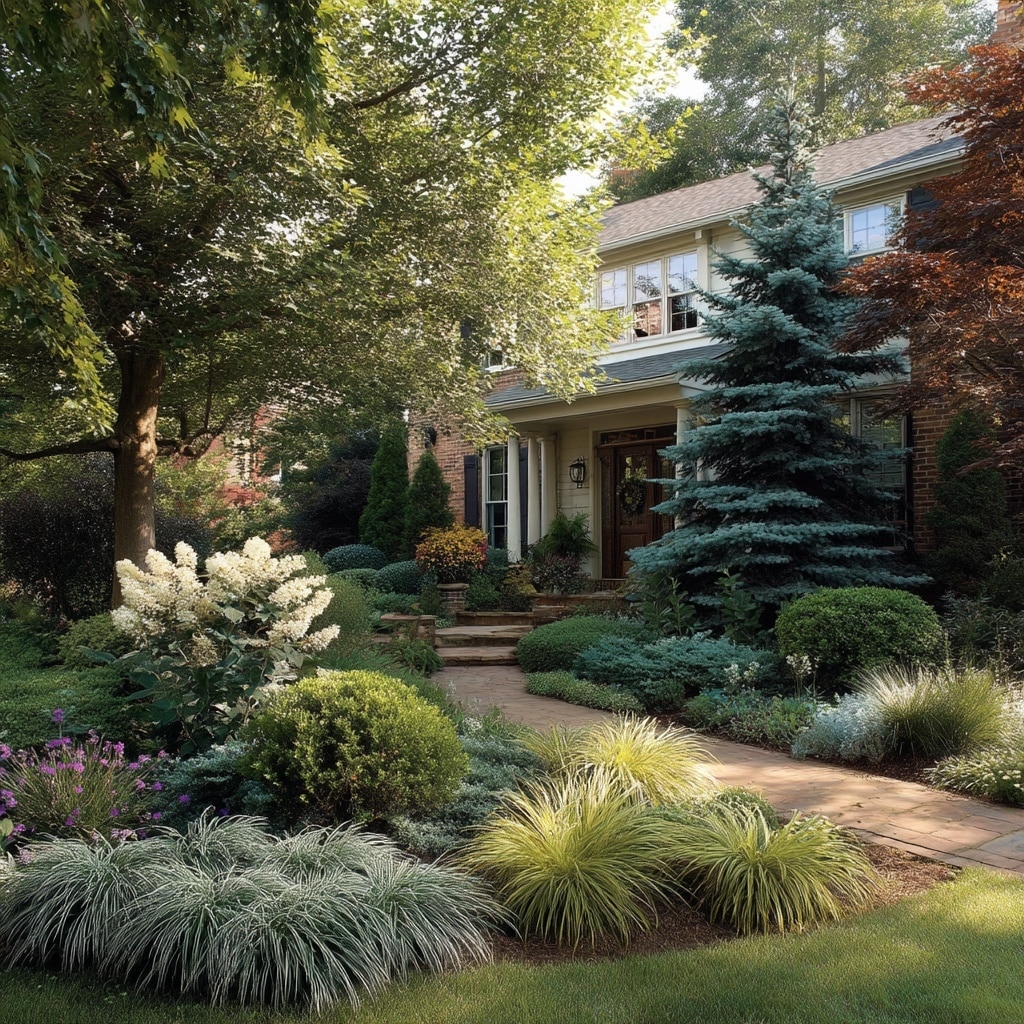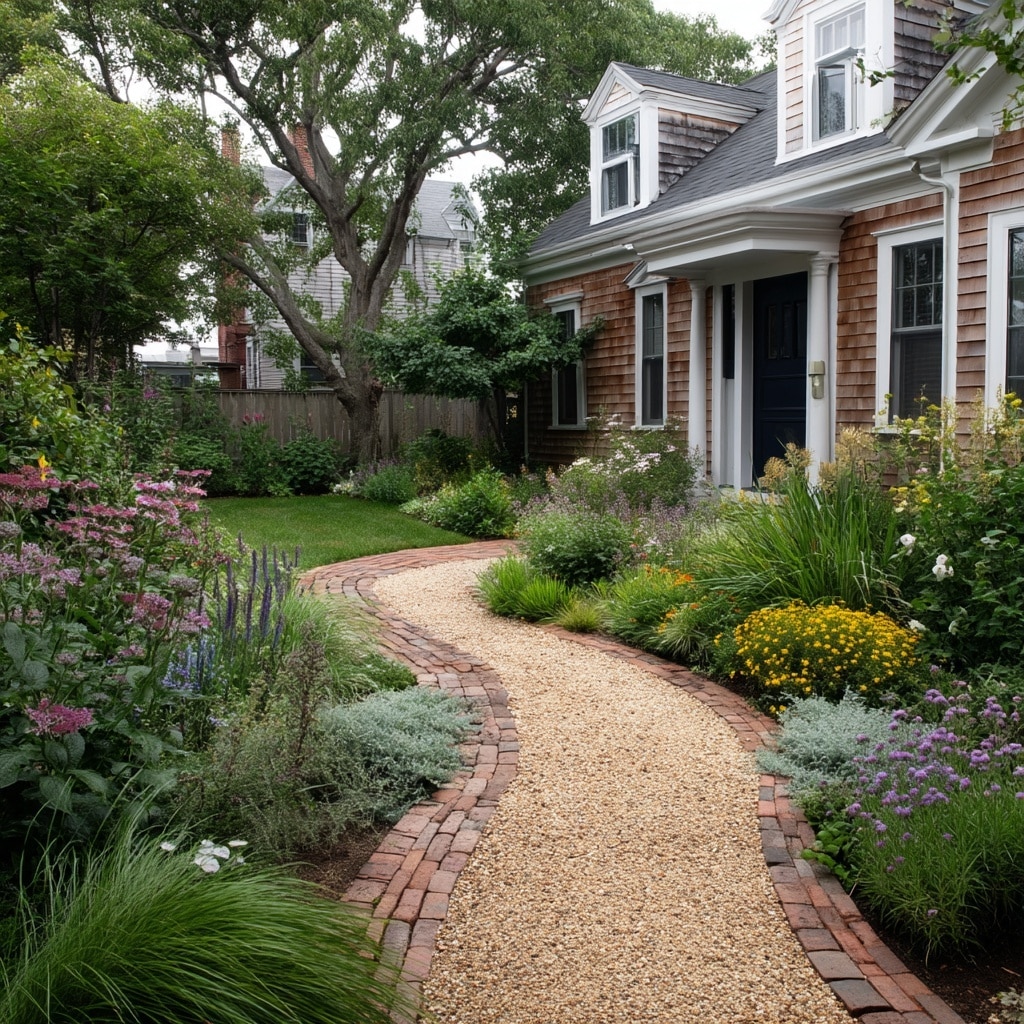Front yard landscaping ideas can make or break the first impression of your home. Whether you have a sprawling lawn or a compact entryway, the right design choices can turn any dull patch of grass into a visually striking and functional outdoor space. From creating beautiful walkways to using climate-friendly plants, updating your front yard doesn’t have to be expensive or overwhelming. With some creativity and planning, you can add curb appeal, increase home value, and even carve out a cozy spot to relax or entertain—all while keeping maintenance low and staying within budget.
Table of Contents
1. Upgrade with Permeable Pathways
When brainstorming practical front yard landscaping ideas, don’t overlook the power of a well-designed pathway. Not only does it guide guests to your front door, but it also helps divide the space, making your yard feel more organized and intentional. Instead of traditional concrete—which can crack over time and restrict water flow—consider more flexible and eco-friendly alternatives.
Permeable pathways, made from brick, flagstone, or gravel set in sand, allow rainwater to naturally drain into the ground. This reduces runoff, prevents puddles, and helps nourish surrounding plants. It’s an excellent low-maintenance solution, especially if you’re aiming for a sustainable garden design. Sand-set pavers also offer design flexibility, letting you create curves or patterns to suit your style.
Bonus Tip:
Use contrasting materials like crushed granite or river rocks to define edges and create a polished look. Adding solar lights along the path can enhance both safety and evening curb appeal.
2. Incorporate Natural Stonework for Texture and Durability

If you’re looking to add timeless charm to your front yard landscaping ideas, natural stonework is a standout feature that brings both structure and sophistication. Unlike synthetic materials, real stone blends seamlessly into almost any outdoor design, whether you’re going for modern minimalism or rustic elegance.
You can use stone in a variety of ways—create edging for flower beds, build small retaining walls, line your garden pathways, or even craft stone steps if your yard is slightly elevated. The durability of stone means it will age beautifully with little to no upkeep, making it a smart investment for homeowners who want long-term results without constant maintenance.
For a DIY-friendly project, start small by incorporating decorative stone borders around planters or trees. If you’re planning something more substantial—like a tiered garden or stairway—it may be worth consulting with a local masonry expert to ensure safety and longevity.
Why it works:
- Enhances visual interest through texture
- Withstands weathering for decades
- Complements both plants and structural elements
3. Design with Microclimates in Mind
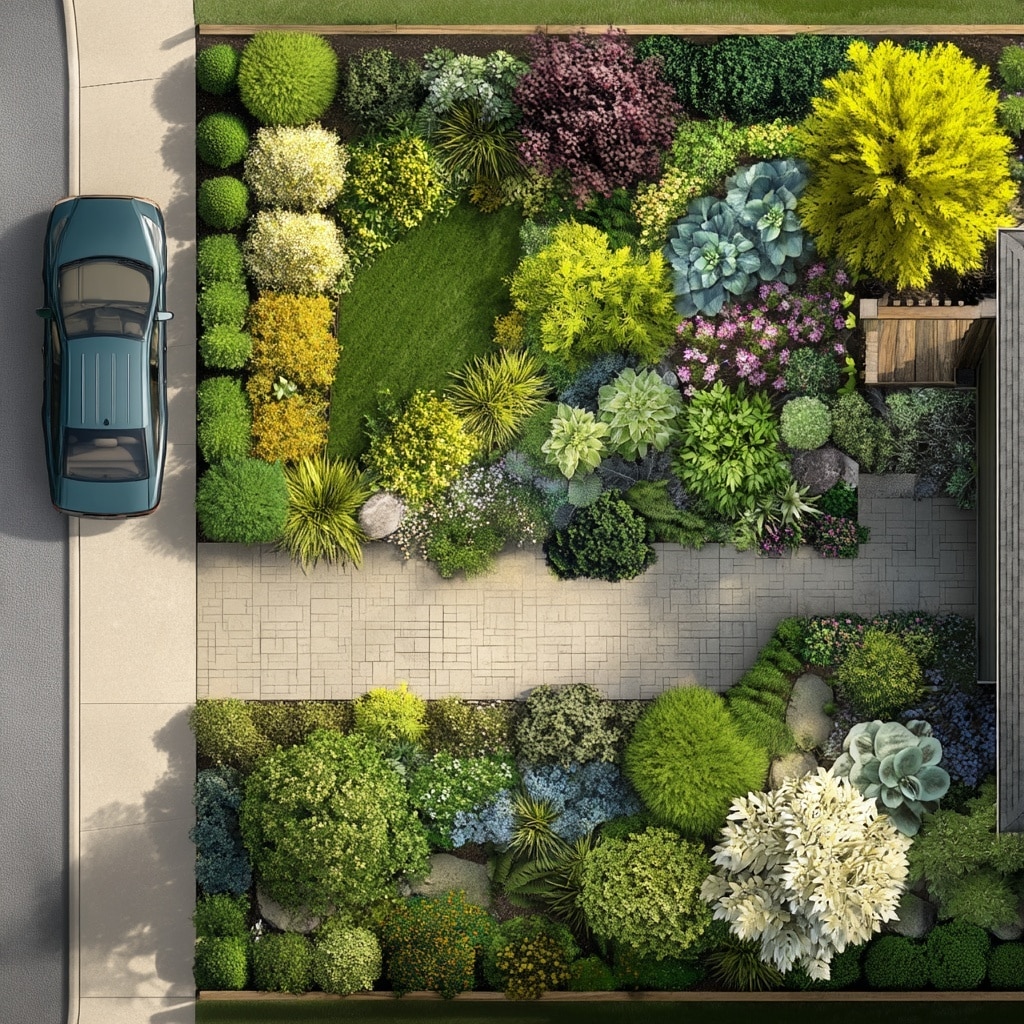
One of the most overlooked yet essential front yard landscaping ideas is working with your yard’s natural microclimates. Even in small spaces, factors like sun exposure, shade, wind, and soil moisture vary dramatically from one area to another. By identifying these microzones, you can select plants that thrive exactly where they’re planted—leading to healthier growth and lower maintenance.
For instance, shady corners near the porch may be perfect for ferns or hostas, while sunny spots near the driveway can host drought-tolerant grasses or flowering perennials. Areas that collect extra moisture after rainfall are ideal for water-loving varieties like hydrangeas or ornamental sedges.
How to get started:
- Observe your front yard at different times of day
- Note where water collects after rain
- Identify compacted, dry, or extra sunny spots
- Choose plants suited to each zone’s specific needs
Designing with microclimates in mind turns a one-size-fits-all yard into a dynamic, thriving ecosystem that looks good all year long.
4. Build Raised Flower Beds for Structure and Style

If you’re aiming to refresh your curb appeal, raised flower beds are one of the smartest front yard landscaping ideas you can implement. They create visual depth, define planting zones, and add a neat, polished look to your front yard—especially helpful if you’re working with a sloped or uneven space.
Raised beds can be built using a variety of materials—natural stone, brick, wood, or even metal—depending on your aesthetic and budget. These beds aren’t just for show, either. They improve drainage, keep soil warmer for longer growing seasons, and reduce weed competition. Plus, they make planting and maintenance easier on your back and knees.
Raised beds also give you an opportunity to layer plant heights and colors more effectively. You can place taller grasses or flowering shrubs in the back, with cascading annuals or ground covers spilling over the edges in front.
Pro Tip:
Incorporate edging stones or a low retaining wall around your raised beds to tie them into existing hardscape features like walkways or patios.
5. Create a Social Space in Your Front Yard
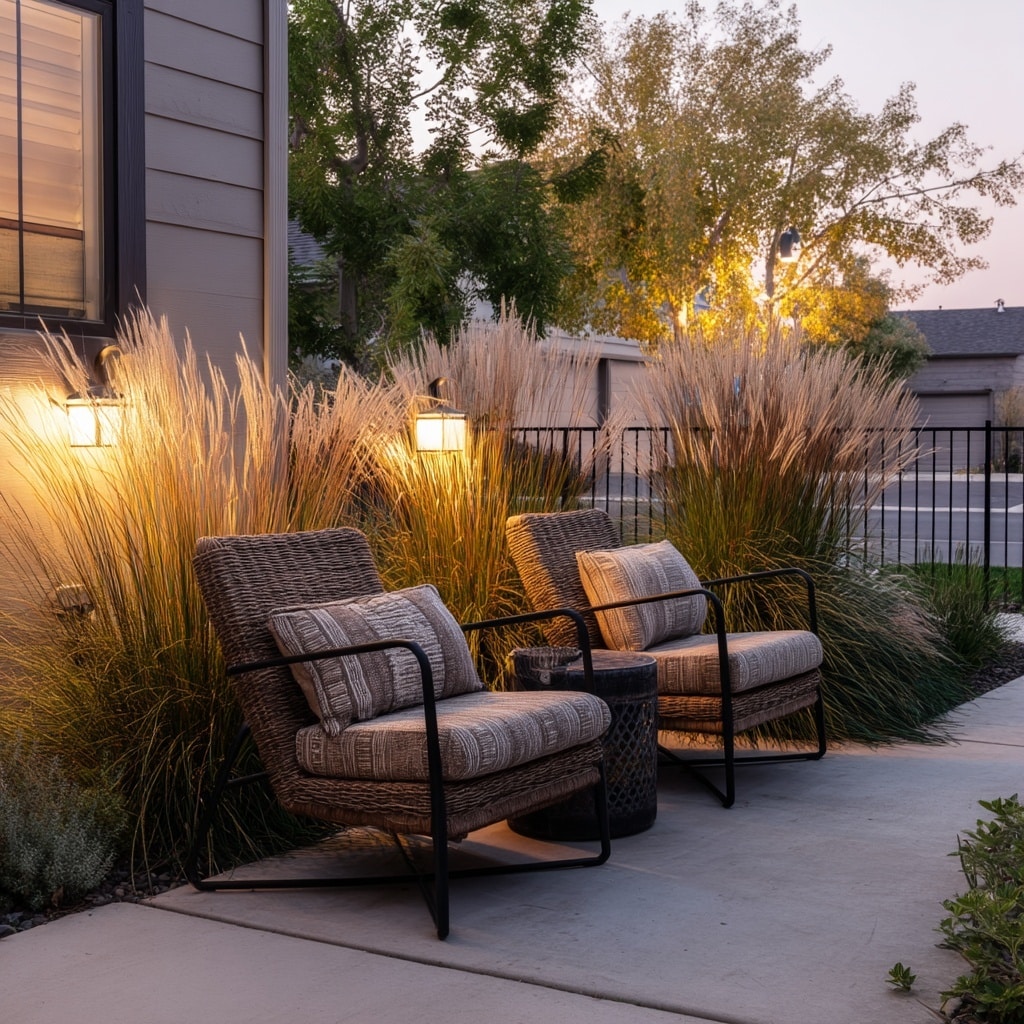
When thinking about front yard landscaping ideas, most homeowners focus on visual appeal—but why not add function too? Turning your front yard into a casual social space not only increases your home’s usable area but also invites friendly connections with neighbors and passersby.
Start by identifying a cozy spot near your porch, under a tree, or even in a sunny corner of your lawn. Add a small seating area with weather-resistant chairs, a bench, or even a porch swing. To make it feel more private without completely closing it off, use soft landscaping techniques—like tall ornamental grasses, potted plants, or low hedges—to create a sense of enclosure.
You can enhance the atmosphere with:
- Solar-powered lanterns or string lights
- A small fire pit or water feature
- Raised planters for added greenery and color
- A gravel or paver base to define the zone
This type of space works beautifully for morning coffee, evening chats, or just enjoying your front yard more mindfully. With the right elements, your yard becomes more than just a pretty backdrop—it becomes part of your everyday lifestyle.
6. Add Low-Maintenance Succulents for Texture and Color
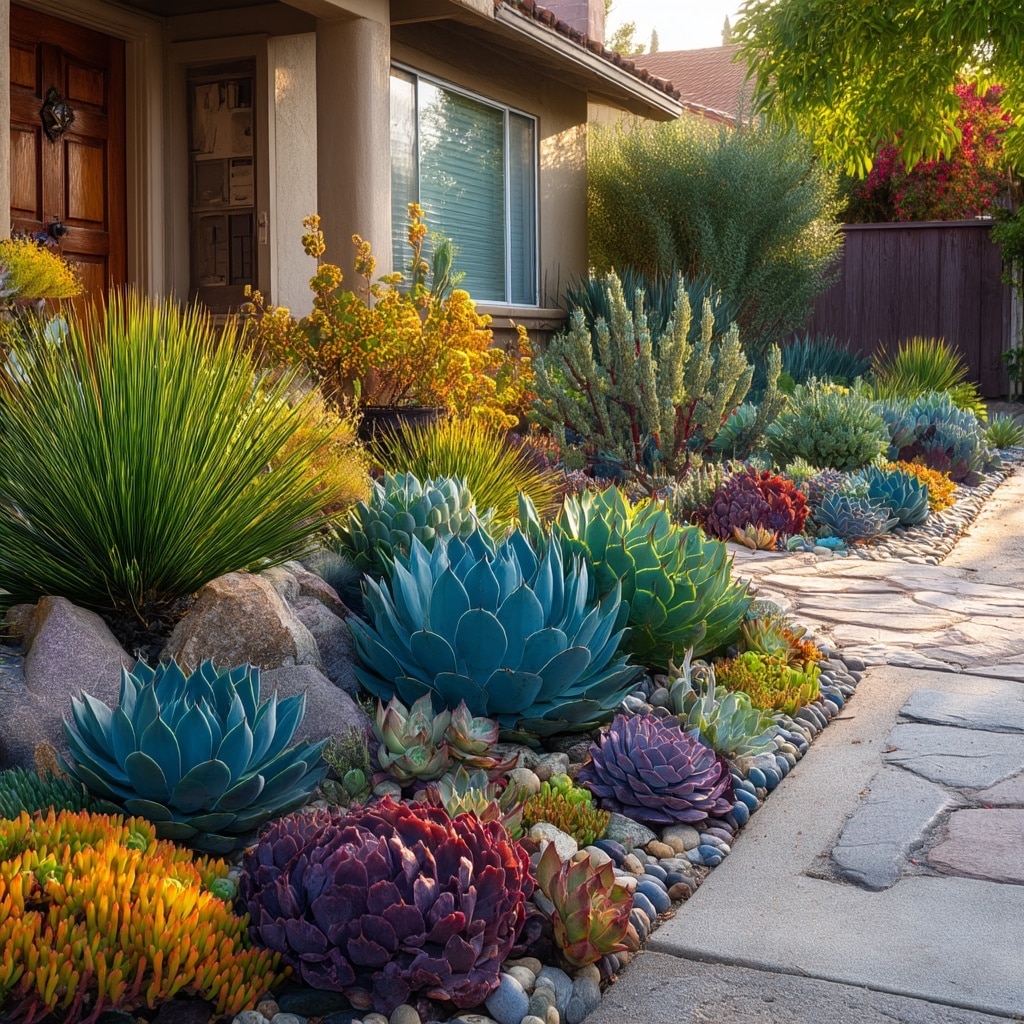
For homeowners looking for stylish yet easy-care front yard landscaping ideas, succulents are an ideal choice. These hardy plants are perfect for hot, dry climates and thrive with minimal watering—making them an excellent solution for drought-prone areas or anyone aiming for a water-wise garden.
Succulents come in an incredible variety of colors, shapes, and sizes, from sculptural agaves to rosette-shaped echeverias and cascading sedums. You can group them in garden beds, edge your pathways with them, or plant them in decorative containers near your front entrance.
Why succulents make sense:
- Require little watering once established
- Tolerant of poor soils and full sun
- Add architectural interest year-round
- Excellent for xeriscaping and modern designs
If you live in a colder region, opt for hardy varieties like hens and chicks (Sempervivum) or stonecrop (Sedum). For tender types, planting in containers makes it easy to bring them indoors during harsh winters.
Design tip:
Mix succulents with gravel mulch or stone borders to create a minimalist, contemporary look while keeping maintenance to a minimum.
7. Design for All Seasons with Strategic Planting

One of the most sustainable and visually appealing front yard landscaping ideas is designing with all four seasons in mind. Instead of planting solely for spring or summer, think about how your yard will look in autumn and winter too. With a little planning, you can enjoy color, texture, and interest all year long.
Start with evergreens like boxwood, holly, or dwarf spruce to provide a green backbone even during the colder months. Next, add perennials such as coneflowers, black-eyed Susans, and salvia to bring vibrant blooms from spring through late summer. Round it out with seasonal annuals or bulbs like tulips in spring and chrysanthemums in fall for rotating color.
Don’t forget structural interest—plants like ornamental grasses and red twig dogwood can add movement and color contrast even in winter. The key is layering textures, heights, and colors that shift naturally with the seasons.
Quick planting guide for year-round appeal:
- Spring: Bulbs (tulips, daffodils), early-blooming perennials
- Summer: Coneflowers, lavender, ornamental grasses
- Fall: Asters, sedums, autumn leaves from deciduous shrubs
- Winter: Evergreens, decorative bark, berries, grasses
A year-round approach adds depth to your landscaping and ensures there’s always something beautiful to see from the curb.
Conclusion
Transforming your home’s curb appeal doesn’t have to be expensive or complicated. With the right front yard landscaping ideas, you can create a space that is not only beautiful but also functional and reflective of your personal style. From adding low-maintenance succulents to building raised beds and creating inviting social spaces, small changes can lead to big visual impact. And by planning for all seasons and working with your yard’s natural layout, you’ll enjoy a front yard that looks great year-round—with less effort.
Start small, stay consistent, and soon your front yard will become one of your favorite features of your home.

